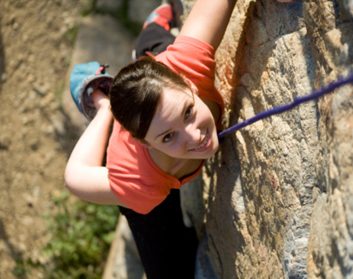How to fall in love with rock climbing
Want to try rock climbing? Here’s how to get started ‘ and love every minute of it

Source: Best Health magazine, Summer 2013; Image: Thinkstock
The thrill of rock climbing
I’m hanging off the side of a 30-foot cliff in Ontario’s Niagara Escarpment on a warm, breezy summer’s day, swinging gently in my harness as I shake out my arms and stare up at the rock face in frustration. My muscles are tired and part of me wants to give up, but I know I should be able to reach the ledge above, a move that keeps eluding me. So after dipping my hands in my chalk bag and brushing off the excess, I get back into position: left foot secure on a small shelf and left hand gripping the rock, I lift my right toe into a small crack higher up’and this time, as I shift my weight to my right leg and lunge upward, my right hand catches hold of the small ledge above me. From here, it’s just a few moves to the top, where I’m able to catch my breath, completely at peace and away from the worries and stresses of everyday life.
How to get started with rock climbing
I started rock climbing about seven years ago to spend time with my boyfriend, wanting to share the sport he had become so obsessed with. But I never expected to find such satisfaction in it myself, both physically’in the pleasure of building enough strength to haul my body against gravity in progressively more challenging ways’and mentally, because it forces me to leave all my troubles behind.
‘What I like about rock climbing is the pure focus,’ says long-time climber Dave Stark, director of operations at Yamnuska Mountain Adventures in Canmore, Alta.
‘I think a lot of people like that aspect of climbing. You really do have to be mentally present to do it. If you start to think about something else, you’ll slip off the rock. You won’t be able to make the move you want to because you won’t be purely focused on it. It brings your body’s movement and your thought together.’
What to expect from a rock climbing course
At Yamnuska, climbers of all levels can sign up for instructional courses and trips that let them experience the Rocky Mountains up close and personal. Beginners, for instance, will start with a safety and goal-setting session, then be fitted for gear: a harness that secures around the waist and thighs, a helmet to deflect any falling rocks, and tight-fitting rubber-soled climbing shoes that help feet find purchase on rock. While climbers tend to go barefoot inside their shoes, you might want thin socks to wear inside the rented shoes, along with loose-fitting long pants that will feel comfortable inside a harness and protect legs from scratches and scrapes. On top, layers that are easily adjusted in changeable mountain weather are ideal.
Basic climbing skills
You’ll begin by learning footwork and climbing skills while bouldering‘that’s a style of climbing that’s done on large boulders that are low to the ground, practised rope-free and with spotters so you can have a chance to get the feel for climbing without worrying about heights and equipment. This way you can work up to climbing rock faces.
Then you’ll learn to ‘tie in”attach your harness to the rope, which loops through two anchors bolted to the top of the rock and is attached at the other end, via safety gear, to your belayer, the climbing partner who ensures the rope is taut as you move upward. ‘The concept is that for any fall, your weight gets immediately put onto the rope and you’re stopped by the belay,’ says Stark. The gear that connects your climbing partner’s harness to the rope automatically catches when it feels a pull, much like a seat belt. ‘You’re not going to fall anywhere.’
Is rock-climbing scary?
Even so, I won’t lie’rock climbing can be scary, even if, like me, you’re not usually afraid of heights. You have to learn to trust yourself and relax as you ascend‘tense muscles get tired faster’and trust your gear as well, allowing it to do its job. But the benefits are worth it: In 30 minutes of ascending, a 150-lb. woman burns an average of 390 calories. And in addition to building balance and strength in your arms, legs and core, you’re going out of your comfort zone, learning that you can be capable of more than you might have thought. Says Stark: ‘Part of the challenge of climbing is overcoming that fear and pushing that edge.’
This article was originally titled "Living on the edge" in the Summer 2013 issue of Best Health. Subscribe today to get the full Best Health experience’and never miss an issue!




